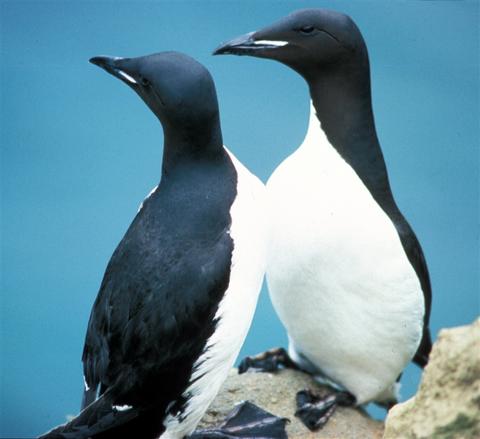
A study by the National Institute of Standards and Technology and Emory University found that the concentrations of certain pollutants in the eggs of thick-billed murres fluctuated in sync with the sea surface temperatures associated with the Pacific Decadal Oscillation pattern of climate variability.
Researchers at the National Institute of Standards and Technology and Emory University have discovered that some bird species in the sub-Arctic tend to ingest larger amounts of pollutants than others during periods of climate variation.
The study, which was published in the journal Chemosphere, examined the eggs of two similar bird species that live very close to each other along the coasts of the Bering Sea and the Gulf of Alaska, the thick-billed murre (Uria lomvia) and the common murre (Uria aalge). Despite their similarities, the thick-billed murres’ ingestion of environmental contaminants is more variable than that of their cousins, the common murres.
Like many areas, the Alaskan regions where these two species often feed have seen increases in persistent organic pollutants (POPs) during the last century. Many of those chemicals were deposited as air pollutants that originated in other, more southerly parts of the world. Other POPs are legacies of old manufacturing processes.
As their name implies, POPs are slow to break down and remain in the environment for very long periods of time. They also move through ecosystems: As they are eaten by animals higher and higher on the food chain, they accumulate, meaning that the larger, older predators tend to ingest more POPs and have higher exposures. This includes humans who eat meat, including these birds, and fish. It also includes birds who eat lots of fish from the sea.
To determine the impact of POPs, scientists have been collecting data since 1999 through a program called the Seabird Tissue Archival and Monitoring Project (STAMP). STAMP is an ongoing, long-term effort to track geographic and temporal trends in the environment by collecting and analyzing seabird eggs as a proxy for ocean and human health. Collection is done using standardized protocols, and specimens are banked under conditions that ensure chemical stability for decades of storage.
The specimens provide lots of different types of information over time, including about changes in the levels of contaminants such as chlorinated pesticides, polychlorinated biphenyls (PCBs), brominated flame retardants and mercury in animal species. The seabird egg collection is housed in NIST’s Biorepository at the Hollings Marine Laboratory in Charleston, South Carolina. Outside researchers may request samples, called aliquots, if certain requirements are met.
Though the two bird species included in the most recent NIST study live in close proximity to one another and eat from the same general waters, the common murre eggs did not experience the same fluctuations in POPs as those of the thick-billed murre.
NIST scientist Stacy Schuur says she began to think there might be a climate connection after examining the first 10 years of data from STAMP. She noticed that the graphs for POPs in birds had a familiar pattern.
“Looking at the data, I saw that it was a lot like the fluctuation over time for sea surface temperatures in El Niño and La Niña years,” Schuur said.
Schuur examined the Pacific Decadal Oscillation (PDO), which measures conditions similar to the El Niño-Southern Oscillation (ENSO), but for the Northern Pacific. During the PDO, a giant, horseshoe-shaped mass of water extending from the coasts of Asia toward North America above 20 degrees north latitude alternates between cooler and warmer temperatures, with phases indicated by water temperatures along the west coast of North America. The PDO is different from the phases that govern ENSO because the PDO trends can last longer — up to decades. Both patterns consist of warm and cool phases linked to sea surface temperatures.
Climate shifts like the PDO can cause an increase in hurricanes, droughts and floods along the coastline. They can also change the productivity of the ocean’s ecosystems and may affect the persistence and availability of certain chemicals.
When Schuur overlaid the thick-billed murre egg data on PDO data, she found that they were almost entirely synchronized. That’s when she teamed up with researchers at Emory University who statistically modeled changes in PDO with pollutant levels in the murre eggs.
The eggs of the thick-billed murres had lower levels of some POPs when the oceans were going through extreme warm or cold phases of the PDO. Conversely, when the oceans were in the neutral phase, those contaminants increased.
There did not seem to be a similar trend occurring across the common murre eggs, contaminants and the PDO. This may be explained by the birds’ different feeding habits. The thick-billed murres tend to dive deeper, venture farther offshore and eat a more varied diet than the common murres.
“Climate variability and contaminants in seabird eggs is a complex story,” Schuur said. “This study illustrates the benefit of the NIST Biorepository. We have decades of samples, including from other marine organisms. We can use these samples to retrospectively examine long-term trends that may not have been conceived when collections began. Collaborative research using these samples is invaluable for understanding our interconnectedness to the natural world and the vulnerability we have to climate changes and pollutant levels.”
Paper: V. Kalia, S. Schuur, K. Hobson, H. Chang, L. Waller, S. Hare and M. Gribble. Relationship between the Pacific Decadal Oscillation (PDO) and bioaccumulation of persistent organic pollutants in sympatric Alaskan seabird (Uria aalge and U. lomvia) eggs between 1999 and 2010. Chemosphere. Published online August 10, 2020. DOI: 10.1016/j.chemosphere.2020.127520

